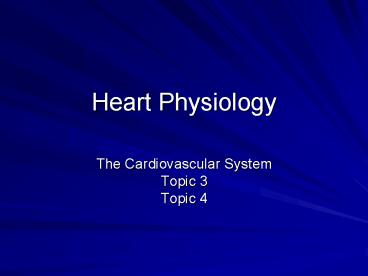Heart Physiology PowerPoint PPT Presentation
1 / 36
Title: Heart Physiology
1
Heart Physiology
- The Cardiovascular System
- Topic 3
- Topic 4
2
Pulmonary Circulation Systemic Circulation
3
Coronary Circulation
- Heart muscle requires constant blood supply
- Right and left coronary arteries
- arise from base of aorta
- Provide oxygenated blood to myocardium
- Myocardium composed of
- Cardiac Muscle Tissue
- 20 more mitochondria than skeletal muscle!
4
4
5
- Cardiac vein
- Collect deoxygenated blood from myocardium
- Drains directly into right atrium!
6
6
7
Coronary Disease
- ANGINA PECTORIS
- Blockage of coronary arteries OR
- Spasm of coronary arteries
- Deficient blood supply to myocardium
- CHEST PAIN
- Treatment Vasodilators
- Most common sign of heart disease in Females
8
- MYOCARDIAL INFARCTION (MI)
- Prolonged blockage of coronary arteries
- Results in death of cardiac muscle cells
- Scar tissue development
- Most dangerous in left ventricular area
- heart attack
- More common sign of heart disease in
- Males
9
Risk Factors
- Genetics
- Age
- Gender
- Diet
- Inactive Lifestyle
- Smoking
10
Artherosclerosis
11
Heart Muscle Contraction
- Neurologically monitored/influenced by the
- AUTONOMIC NERVOUS
- SYSTEM!!
- Medulla Oblongata
- Cranial Nerve X
- Spinal Nerves
12
Parasympathetic
Sympathetic
Modifying the Basic Rhythm
13
Autorhythmicity
- Automatic Rhythm
- Specific areas of heart capable of
self-depolarization! - Depolarization ? Action Potential ? Contraction
of Cardiac Muscle! - Specific Areas compose the
- INTRINSIC CARDIAC CONDUCTION SYSTEM
14
- Specific areas set the pace for rhythmic
contraction of the heart! - Specific areas ensure contraction is
- ALL OR NONE !
- Autorhythmic specific areas compose
- 1 of heart!
15
So what / where are thesespecific areas
- AUTORHYTHMIC CARDIAC CELLS Found in
- Sinoatrial Node (SA Node)
- Atrioventricular Node (AV Node)
- Atrioventricular (AV) Bundle (Bundle of His)
- Bundle Branches
- Purkinje Fibers
16
(No Transcript)
17
So How does it work?
- SA NODE starts it all!
- Generates 75 Action Potentials / minute!
- Sets the pace of hearts rhythmic contractions!
- Aka the PACEMAKER of the Heart!
- Sets pace for 40 60 heartbeats per minute
- (bpm)
18
Pass the Depolarization Game
- SA Node 75 AP / minute
- AV Node 50 AP / minute
- AV Bundle 30 AP / minute
- Bundle Branches 30 AP / minute
- Purkinje Fibers stimulate myocardium
contraction !
19
Other Pacemakers?(other than the SA Node)
- Ectopic Pacemakers
- Cells outside ICCS that become over-stimulated
and produce more APs than SA node! - Most common cause
- Drugs
- Caffeine
- Nicotine
20
- Surgical Implant
- Device inserted into chest regulates ICCS
- Functions in place of defective SA Node!
21
Measuring Electrical Activity
- Electrocardiogram (EKG, ECG)
- Visual depiction of depolarization sequence among
Nodes, bundles, branches, fibers of ICCS. - SA Node
- AV Node
- AV Bundle
- Bundle Branches
- Purkinje Fibers
22
Electrocardiogram
23
NORMAL ECG
24
- P Wave
- SA Node Depolarization through Atria ? Atrial
Contraction! - QRS Wave
- Depolarization through ventricles ? Ventricular
contraction! - T Wave
- Repolarization in ventricles? Ventricular Rest
Period
25
Normal sinus rhythm
No P wave SA node not functioning AV node
pacemaker
26
Extra P waves Heart block
V-fib chaotic ECG no pattern
27
The Cardiac Cycle
Systole--contraction--depolarization
Diastole--relaxation--repolarization
One complete heartbeat
Atrial systole
Atrial diastole
Ventricular systole
Ventricular diastole
28
Start with heart totally relaxed
Period of ventricular filling
Pressure in heart is low, AV valves open,
semilunar valves closed
Blood flowing into atria pass to ventricles--70
Atrial systole forces remaining 30 into
ventricles
Atrial diastole--persists for remainder of
cardiac cycle
29
Ventricular Systole
Atrial relaxation occurs as ventricles begin to
contract
? ventricular pressure closes AV valves
As ventricular pressure exceeds pressure in
attached arteries semilunar valves open
Blood forced into arteries
30
Isovolumetric relaxation
ventricles relax
all valves closed briefly
ventricular pressure drops
31
At 75 bpm total cardiac cycle lasts 0.8 seconds
0.1 seconds--atrial systole
0.3 seconds--ventricular systole
0.4 seconds--diastole
Blood flows along pressure gradient
32
Heart Sounds
Lub-dup
Valves in heart closing
Lub--AV valves closing
Dup--semilunar valves closing
Murmurs--valvular insufficiency
33
Tachycardia--increased heart rate gt100 bpm
Bradycardia--slow heart lt60 bpm
Congestive Heart Failure (CHF)
Weakened myocardium Decrease in pumping
efficiency Circulation not maintained
34
(No Transcript)
35
(No Transcript)
36
(No Transcript)

